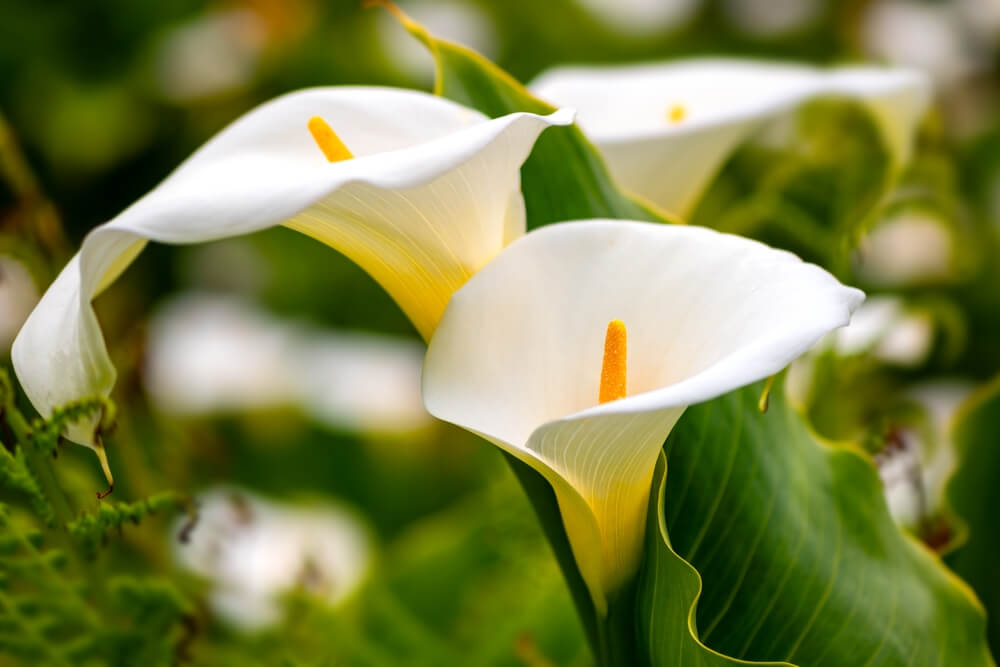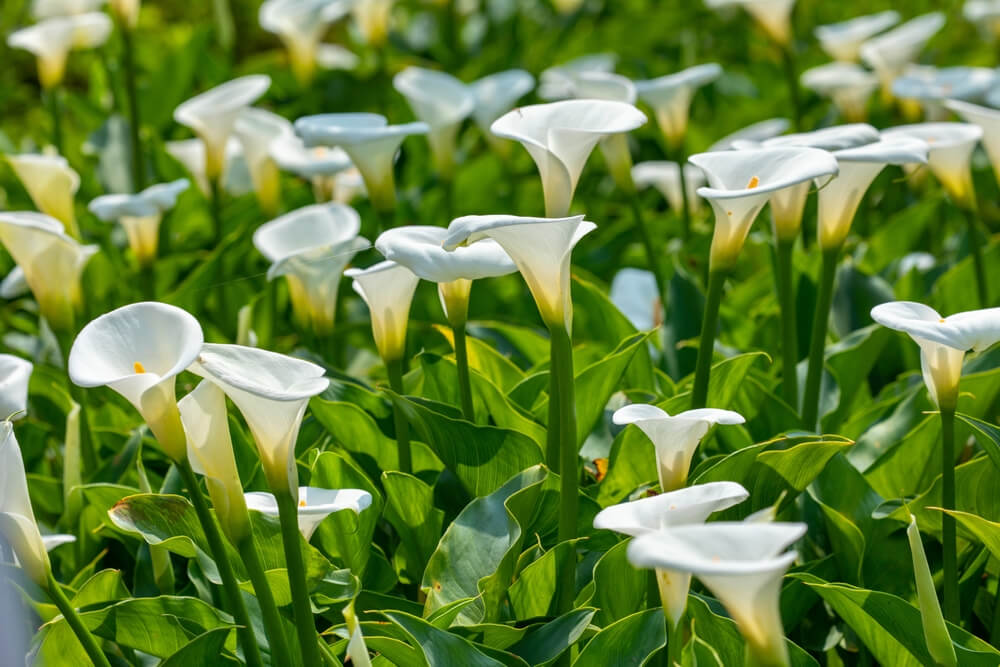
Calla lilies, with their elegant and distinctive appearance, are a favorite among gardeners and floral enthusiasts alike. Originating from Africa, these striking flowers are known for their trumpet-shaped blooms and lush green foliage. The history of calla lilies dates back to ancient times, where they were revered not only for their beauty but also for their symbolic meanings in various cultures.
There are several types of calla lilies to explore, each offering unique characteristics in terms of color and size. The most popular varieties include the classic white calla lily (Zantedeschia aethiopica), which is often associated with purity and elegance, as well as vibrant colored hybrids that range from deep purples to sunny yellows.
When it comes to caring for calla lilies, it’s important to understand their needs to ensure healthy growth. These plants thrive in well-drained soil and prefer a sunny spot with partial shade during the hottest part of the day. Regular watering is essential, especially during the growing season; however, care should be taken not to overwater as this can lead to root rot.
Whether you’re a seasoned gardener or new to plant care, calla lilies offer both beauty and simplicity. With the right conditions and attention, these stunning flowers can be a long-lasting addition to any garden or indoor arrangement.
Essential Growing Conditions for Healthy Calla Lilies

Calla lilies are elegant and striking plants that thrive under specific growing conditions, ensuring their vibrant blooms and lush foliage. Understanding the essential requirements for these plants is key to cultivating healthy calla lilies in your garden or home.
First and foremost, the ideal climate for calla lilies includes mild temperatures, typically between 60-75°F (15-24°C). These plants prefer environments where they can enjoy warm days and cooler nights, making them well-suited to regions with temperate climates. While they can tolerate light frost, it’s important to protect them from prolonged exposure to freezing temperatures.
When it comes to soil requirements for callas, these plants flourish in well-draining soil rich in organic matter. A slightly acidic to neutral pH level is preferred, typically ranging from 6.0 to 6.5. To achieve optimal soil conditions, consider incorporating compost or peat moss into your planting mix; this will enhance drainage while providing essential nutrients.
Sunlight needs are another critical factor in growing healthy calla lilies. These plants require bright but indirect sunlight; too much direct sun can scorch their leaves while too little can hinder bloom production. Ideally, place your callas in a location where they receive morning sun followed by afternoon shade or dappled sunlight throughout the day.
By meeting these essential growing conditions, you can ensure that your calla lilies remain robust and continue to grace your space with their stunning beauty season after season.
Watering and Fertilizing Your Calla Lilies the Right Way
Caring for calla lilies involves understanding their specific watering and fertilizing needs to ensure they thrive beautifully. Establishing a proper watering schedule for callas is essential, as these plants prefer consistently moist, but not waterlogged, soil. Typically, you should water your calla lilies every 2-3 days during the growing season, adjusting the frequency based on the climate and soil conditions. It’s important to let the top inch of soil dry out slightly between waterings to prevent root rot.
When it comes to fertilization, knowing how often to feed your callas is crucial for their health and vibrant blooms. Calla lilies benefit from a balanced fertilizer applied every four weeks during active growth periods. The best fertilizers for calla lilies are those with an equal ratio of nitrogen (N), phosphorus (P), and potassium (K), such as a 10-10-10 or 20-20-20 formula. These provide the necessary nutrient requirements that support robust foliage and stunning flowers.
By adhering to these guidelines on watering and fertilizing your calla lilies correctly, you can enjoy their elegant beauty throughout the growing season while ensuring they remain healthy and flourishing.
Pest and Disease Management in Calla Lily Care
Caring for calla lilies involves not only providing the right growing conditions but also managing pests and diseases that can affect their health. Understanding common pests affecting callas is crucial for maintaining vibrant blooms. Aphids, spider mites, and thrips are among the most frequent culprits. These pests can cause significant damage by sucking sap from the plants, leading to weakened growth and distorted leaves.
Disease prevention in callas is equally important. Fungal infections such as root rot and powdery mildew are common issues that can arise from overwatering or poor air circulation. To prevent these diseases, ensure your calla lilies are planted in well-draining soil and maintain proper spacing to allow airflow.
Implementing effective pest control tips for lilies involves regular monitoring of plants for any signs of infestation or disease. Natural remedies such as neem oil or insecticidal soap can be used to treat minor pest problems without harming beneficial insects. For more severe infestations, consider using targeted insecticides while following label instructions carefully.
Adopting healthy plant practices is key to keeping your calla lilies thriving. Regularly remove any dead or diseased foliage to prevent the spread of pathogens, and ensure your plants receive adequate sunlight and nutrients tailored to their needs. By staying vigilant and proactive in pest and disease management, you can enjoy beautiful, healthy calla lilies throughout their blooming season.
Pruning and Propagation Techniques for Vigorous Growth
Pruning and propagation are essential techniques for maintaining the health and vigor of calla lilies, ensuring they flourish season after season. Understanding how to prune a calla lily plant is crucial for promoting robust growth and preventing disease. Pruning involves removing dead or damaged leaves and spent flowers, which helps redirect the plant’s energy towards new growth. It’s best to prune callas during their dormant period in late fall or early winter, using clean, sharp tools to make precise cuts.
In addition to pruning, propagating callas from bulbs or seeds is an effective way to expand your garden collection. Propagation through bulbs is often preferred due to its simplicity and reliability. After blooming has finished, carefully dig up the bulbs during their dormant phase, separate them from any offsets (small bulb clusters), and replant them in well-draining soil. For those interested in growing callas from seeds, patience is key as this method takes longer but can be rewarding with unique variations.
Enhancing growth through proper pruning not only benefits the individual plant but also contributes to a more vibrant garden overall. Regular maintenance ensures that your calla lilies remain healthy and continue to produce stunning blooms year after year.
Troubleshooting Common Problems with Calla Lilies
Calla lilies are cherished for their elegant flowers and lush foliage, but like any plant, they can encounter a few common issues that may hinder their growth and beauty. Understanding the reasons behind these problems is key to maintaining healthy callas.
One frequent issue gardeners face is browning leaves on callas. This can often be attributed to improper watering either, too much or too little. Calla lilies prefer consistently moist soil, so it’s important to find a balance. Overwatering can lead to root rot, while underwatering might cause the leaves to dry out and turn brown.
Another problem you might encounter is yellowing leaves. This could be due to nutrient deficiencies or poor drainage in the soil. Ensuring your calla lilies have well-draining soil and are fed with a balanced fertilizer can help address these issues. Sometimes, yellowing occurs when plants are stressed by temperature fluctuations or inadequate light conditions.
If you’re wondering, “Why are my flowers not blooming?” there could be several culprits at play. Insufficient sunlight is a common reason; ensure your callas receive enough bright, indirect light for optimal blooming. Additionally, check if they’re overcrowded in their potcallas and need space for root growth. Consider refreshing the soil annually to provide fresh nutrients.
By identifying and fixing these common issues in your care routine, you can help ensure that your calla lilies remain vibrant and continue to grace your garden with their stunning blooms year after year.
Mastering Calla Lily Care for Beautiful Home Gardens Year-Round
Mastering the art of calla lily care can transform your home garden into a vibrant oasis that flourishes year-round. These elegant blooms, known for their striking beauty and graceful form, require specific attention to thrive. By understanding their needs, you can ensure that your calla lilies remain healthy and stunning throughout the seasons.
Firstly, it’s essential to provide them with well-draining soil and adequate sunlight. Calla lilies prefer a spot where they can bask in morning sun while being shielded from harsh afternoon rays. Consistent watering is crucial; however, be cautious of overwatering as it can lead to root rot.
Fertilization plays a significant role in promoting robust growth and prolific blooming. A balanced fertilizer every few weeks during the growing season will keep your plants nourished and vigorous.
Additionally, understanding the dormancy period of calla lilies is vital for long-term care. Allowing them to rest during this phase by reducing water and ceasing fertilization ensures they come back stronger each year.
By implementing these practices, you’ll not only enhance the beauty of your garden but also enjoy the satisfaction of cultivating these exquisite flowers successfully. With dedication and proper care, calla lilies will reward you with their timeless elegance and charm all year round.



